Inge Morath: one of the great female masters of photography, whose visual imagery I love.
“[Inge Morath was] a high priestess of photography… with the rare ability to penetrate beyond surfaces and reveal what makes her subject tick.” – John Huston
Inge Morath assisted Henri Cartier-Bresson (perhaps where she got insight into great and elegant composition) and was one of the early Magnum photographers. I don’t think she is as famous as she should be; so I hope to bring her work to light.
Interesting note, Morath kept this quote from Henri Cartier-Bresson on her mind:
“A good photograph is made when the inner vision behind the closed eye corresponds with the vision of the open one behind the viewfinder in the moment of pressing the button.” – Henri Cartier-Bresson
1. You show your soul through your photos

“Photography is a strange phenomenon… You trust your eye and cannot help but bare your soul.”
When looking at the photos of Inge Morath, I can see her soul. Her playful attitude, and grace.
2. The joy of making photos!
“Pressing the shutter has remained a moment of joyful recognition, comparable to the delight of a child balancing on tiptoe and suddenly, with a small cry of delight, stretching out a hand toward a desired object.”
Inge Morath was quite ‘child-like’ in her photographic approach: making photos that are fun!
3. Making photos is a necessity
“To take pictures had become a necessity and I did not want to forgo it for anything”
I love this — making it your own personal imperative to make photos.
4. Discovering inner-truth through photography
“Photography is essentially a personal matter – a search for inner truth.”
Inge Morath didn’t just make photos for journalistic purpose. She also used photography as a philosophical tool — to search for her own inner-truth; how she saw the world (which I saw as optimistic, joyful, and bright!)
5. Always remain an amateur photographer
” In my heart I like to remain an amateur, in the sense of being in love with what I’m doing, forever astonished again at the endless possibilities of seeing and using the camera as a recording tool.”
Don’t seek to be an indifferent ‘pro’ photographer. Stay an amateur (which means “lover” in Latin). Never lose your hope and optimism for the epic ability of the recording possibilities of the camera!
6. Photographing humans
“I am especially interested in photographing in countries where a new tradition emerges from an ancient one. I am more attracted to the human element than the abstract.”
Photograph more humans!
More inspiration by Inge Morath:
ROAD TO RENO:
“This is the story of my first trip across the United States. It is not really a story, they are bits of notes written each night at a table in a motel room that always was a different place and always looked the same,”
“Cars run like hurried beetles, stuffed with their passengers, men and women and children, with suitcases and paper bags with beds and blankets.”- Inge Morath
“Practically nothing announces the approach of one of the most extraordinary places I was to see on this trip, grown out of the barbaric desires to gamble and gain and forget, Las Vegas suddenly receives you, wearing stage makeup in full daylights with the sophistication of a ham actor in an ambulant road show. The magnificent setting of this highly perishable world of a few boulevards, expensive hotels, motels, slot machines, chemin de Fer tables and chorus girls is the desert. Las Vegas spills you out into it again just a few minutes after you have left its main boulevard and one wonders how long it would take this sand to cover it all up, this heat to dry it all out.”
SPAIN
Inge Morath describes Spain as “ … almost like entering a dream one had had many times. I loved the people, they let me photograph them, but also they wanted me to listen to them, to tell me what they knew, so that we told their story together”.
Inge Morath desired (through photography) to:
“Express the things I wanted to say, giving them form through my eyes.”
Great Female Masters of Photography

Men are over-represented in photography. Here are some great female photographers to know:
The Female Masters of Photography

- Inge Morath: Contemporary of Henri Cartier-Bresson, did epic photos of fashion, travels, with poetry and humanism.
- Diane Arbus: Famous for her medium format flash photos, photographing the “outcasts” of society in an empathetic way. Unfortunately committed suicide.
- Dorothea Lange: Famous for FSA photos of Dust Bowl and Great Depression. Iconic Migrant Mother photo.
- Helen Levitt: Best classic street photographer, photographed children. Innovative color street photos.
- Mary Ellen Mark: Probably one of the best composition photographers. Epic projects. My personal favorite female photographer. Great teacher, and timeless photos. Passed away recently.
- Vivian Maier: Chicago Nanny, Whose passion was photography on the side. Discovered by John Maloof. Empathetic photos of everyday life, and pioneering color 35mm work as well as great street portraits in black and white on her Rolleifex
- Zoe Strauss: Best living Magnum female photographer. Very down to earth, and has documented many individuals living with abusive partners. My favorite living female photographer.
- Martine Franck: Wife of Henri Cartier-Bresson. I prefer her work over his. Strong layers and clean compositions.
Who are your favorite female photographers? Contribute your recommendations on ERIC KIM FORUM.
Learn From the Masters

Start here:


























































